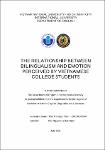| dc.description.abstract | The study of the correlation between language and emotion is an emerging area of
enquiry which has attracted many researchers. Dewaele and Nakano (2012) conducted
a study examining multilinguals’ perceptions of being different when using different
languages and discovered a systematic shift on most feelings scales. Their findings
support the existence of a relationship between bi-/ multilingualism and emotion. The
present study aims to pursue this line of research in the Vietnamese context by
investigating 160 Vietnamese-English speaking students at International University
(IU) (VNU_HCMC). They were asked to complete a questionnaire based on the
Bilingualism and Emotion Questionnaire (Dewaele & Pavlenko, 2001–2003). It
includes closed questions regarding shifts on specific feelings scales and an open
question for explaining the difference perceived. The scales, chosen with reference to
the research of Dewaele and Nakano (2012), consist of feeling logical, serious,
emotional, fake, and different. The results of quantitative analyses revealed a regular
shift on most scales, with most participants feeling more logical, more serious, more
fake, more different, and less emotional when using the L2. Simple linear regression
revealed that the variation in certain feelings scales was mostly predicted by selfperceived proficiency in the L2. | en_US |


